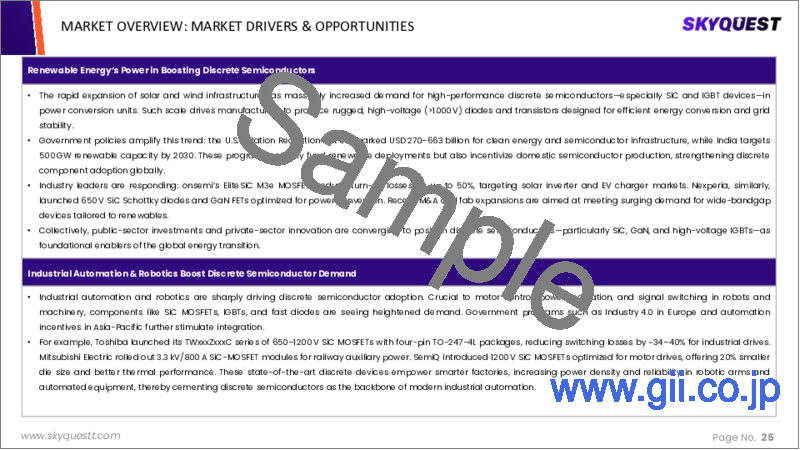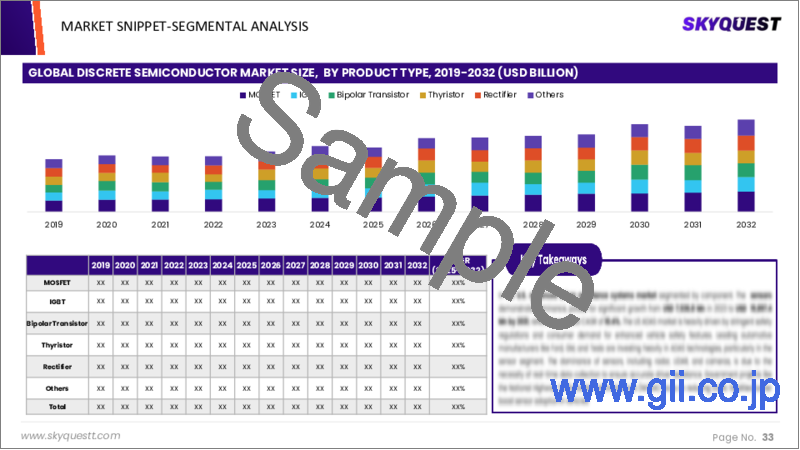|
|
市場調査レポート
商品コード
1724913
ディスクリート半導体市場規模、シェア、成長分析、製品別、技術別、用途別、最終用途別、地域別 - 産業予測、2025-2032年Discrete Semiconductor Market Size, Share, and Growth Analysis, By Product (MOSFET, IGBT), By Technology (Silicon, Silicon Carbide), By Application, By End-Use, By Region - Industry Forecast 2025-2032 |
||||||
|
|||||||
| ディスクリート半導体市場規模、シェア、成長分析、製品別、技術別、用途別、最終用途別、地域別 - 産業予測、2025-2032年 |
|
出版日: 2025年05月11日
発行: SkyQuest
ページ情報: 英文 188 Pages
納期: 3~5営業日
|
全表示
- 概要
- 目次
ディスクリート半導体の世界市場規模は、2023年に572億米ドルと評価され、予測期間(2025-2032年)のCAGRは8.8%で成長し、2024年の622億3,000万米ドルから2032年には1,222億米ドルに成長する見通しです。
世界のディスクリート半導体産業は、モバイル接続性の向上とテクノロジーの進歩に後押しされ、著しい成長を遂げています。2023年までに70億近くのスマートフォン契約が見込まれ、この数字は2028年までに77億を超えると予測され、スマートフォン、IoT、5Gネットワークにおけるディスクリート半導体の需要を牽引しています。しかし、特にロシア・ウクライナ紛争に関連する地政学的緊張が原材料サプライチェーンを緊張させており、特にネオンガスの入手可能性に影響を与えています。これに対応するため、メーカーは積極的に調達先を多様化し、より安全な地域への設備移転を進めています。例えば、テスラは地政学的リスクを軽減するため、中国や台湾から生産拠点を移すようサプライヤーに指示しました。このような進化する貿易力学と技術革新は、強固な半導体製造とサプライチェーン戦略への投資を促進し、市場を長期的な成長に位置づけています。
目次
イントロダクション
- 調査の目的
- 調査範囲
- 定義
調査手法
- 情報調達
- 二次と一次データの方法
- 市場規模予測
- 市場の前提条件と制限
エグゼクティブサマリー
- 世界市場の見通し
- 供給と需要の動向分析
- セグメント別機会分析
市場力学と見通し
- 市場概要
- 市場規模
- 市場力学
- 促進要因と機会
- 抑制要因と課題
- ポーターの分析
主な市場の考察
- 重要成功要因
- 競合の程度
- 主な投資機会
- 市場エコシステム
- 市場の魅力指数(2024年)
- PESTEL分析
- マクロ経済指標
- バリューチェーン分析
- 価格分析
- 規制情勢
- ケーススタディ
- 技術分析
ディスクリート半導体市場規模:製品別
- 市場概要
- 電界効果トランジスタ(MOSFET)
- 絶縁ゲート型バイポーラトランジスタ(IGBT)
- バイポーラトランジスタ
- サイリスタ
- 整流器
- その他
ディスクリート半導体市場規模:技術別
- 市場概要
- シリコン
- 炭化ケイ素
- 窒化ガリウム
- ガリウムヒ素
ディスクリート半導体市場規模:用途別
- 市場概要
- コンシューマーエレクトロニクス
- 自動車
- 産業
- 通信
- エネルギー管理
ディスクリート半導体市場規模:最終用途別
- 市場概要
- 商業用
- 住宅用
- 産業用
ディスクリート半導体市場規模
- 北米
- 米国
- カナダ
- 欧州
- ドイツ
- スペイン
- フランス
- 英国
- イタリア
- その他欧州地域
- アジア太平洋地域
- 中国
- インド
- 日本
- 韓国
- その他アジア太平洋地域
- ラテンアメリカ
- ブラジル
- その他ラテンアメリカ地域
- 中東・アフリカ
- GCC諸国
- 南アフリカ
- その他中東・アフリカ
競合情報
- 上位5社の比較
- 主要企業の市場ポジショニング(2024年)
- 主な市場企業が採用した戦略
- 最近の市場動向
- 企業の市場シェア分析(2024年)
- 主要企業の企業プロファイル
- 企業の詳細
- 製品ポートフォリオ分析
- 企業のセグメント別シェア分析
- 収益の前年比比較(2022-2024年)
主要企業プロファイル
- ON Semiconductor(USA)
- Infineon Technologies AG(Germany)
- STMicroelectronics(Switzerland)
- Texas Instruments(USA)
- Vishay Intertechnology(USA)
- Renesas Electronics Corporation(Japan)
- Toshiba Electronic Devices & Storage Corporation(Japan)
- ROHM Co., Ltd.(Japan)
- Diodes Incorporated(USA)
- Fuji Electric Co., Ltd.(Japan)
- Microchip Technology Inc.(USA)
- Analog Devices, Inc.(USA)
- Eaton Corporation PLC(Ireland)
- ABB Ltd(Switzerland)
- Hitachi Ltd.(Japan)
- Littelfuse Inc.(USA)
- Semikron Danfoss Holding A/S(Germany)
結論と提言
Global Discrete Semiconductor Market size was valued at USD 57.2 billion in 2023 and is poised to grow from USD 62.23 billion in 2024 to USD 122.2 billion by 2032, growing at a CAGR of 8.8% during the forecast period (2025-2032).
The global discrete semiconductor industry is experiencing significant growth, fueled by rising mobile connectivity and advancements in technology. By 2023, nearly seven billion smartphone subscriptions are anticipated, with this figure projected to surpass 7.7 billion by 2028, driving demand for discrete semiconductors in smartphones, IoT, and 5G networks. However, geopolitical tensions, particularly related to the Russia-Ukraine conflict, are straining raw material supply chains, notably affecting neon gas availability. In response, manufacturers are proactively diversifying their sources and relocating facilities to safer regions. For example, Tesla has directed its suppliers to shift production away from China and Taiwan to mitigate geopolitical risks. These evolving trade dynamics and technological innovations are fostering investments in robust semiconductor manufacturing and supply chain strategies, positioning the market for long-term growth.
Top-down and bottom-up approaches were used to estimate and validate the size of the Global Discrete Semiconductor market and to estimate the size of various other dependent submarkets. The research methodology used to estimate the market size includes the following details: The key players in the market were identified through secondary research, and their market shares in the respective regions were determined through primary and secondary research. This entire procedure includes the study of the annual and financial reports of the top market players and extensive interviews for key insights from industry leaders such as CEOs, VPs, directors, and marketing executives. All percentage shares split, and breakdowns were determined using secondary sources and verified through Primary sources. All possible parameters that affect the markets covered in this research study have been accounted for, viewed in extensive detail, verified through primary research, and analyzed to get the final quantitative and qualitative data.
Global Discrete Semiconductor Market Segments Analysis
Global Discrete Semiconductor Market is segmented by Product, Technology, Application, End-Use and region. Based on Product, the market is segmented into MOSFET, IGBT, Bipolar Transistor, Thyristor, Rectifier and Other. Based on Technology, the market is segmented into Silicon, Silicon Carbide, Gallium Nitride and Gallium Arsenide. Based on Application, the market is segmented into Consumer Electronics, Automotive, Industrial, Telecommunications and Energy Management. Based on End-Use, the market is segmented into Commercial, Residential and Industrial. Based on region, the market is segmented into North America, Europe, Asia Pacific, Latin America and Middle East & Africa.
Driver of the Global Discrete Semiconductor Market
The global discrete semiconductor market is significantly driven by the rising demand for electric vehicles (EVs). Key components such as rectifiers, power transistors, and diodes play a vital role in EV powertrains, battery management systems, and charging solutions. Additionally, this market growth is bolstered by government initiatives and regulatory pressures aimed at reducing emissions, prompting companies to invest in advanced power semiconductors. These investments focus on improving vehicle performance and enhancing energy efficiency, further fueling the demand for discrete semiconductors in the automotive sector. As such, the interplay of technological advancement and regulatory support continues to shape this dynamic market.
Restraints in the Global Discrete Semiconductor Market
The global discrete semiconductor market faces significant constraints due to geopolitical tensions, trade restrictions, and the scarcity of essential raw materials. The ongoing conflict between Russia and Ukraine has disrupted the supply of neon gas, which is crucial for chip production. Furthermore, the trade barriers imposed between the United States and China have adversely affected semiconductor manufacturing, leading to fluctuations in pricing and even halts in production for certain semiconductor components. These challenges create uncertainty within the market, hindering growth and stability as companies navigate a complex landscape of supply chain disruptions and varying international trade dynamics.
Market Trends of the Global Discrete Semiconductor Market
The global discrete semiconductor market is witnessing a significant shift towards wide bandgap semiconductors, particularly gallium nitride (GaN) and silicon carbide (SiC). These materials are gaining traction due to their exceptional high-speed characteristics, thermal resistance, and power efficiency, positioning them as game-changers in high-frequency communications, renewable energy, and electric vehicle applications. Major players like Infineon and STMicroelectronics are heavily investing in the development of GaN and SiC technologies to enhance their efficiency and capitalize on the growing demand for energy-efficient solutions. This trend underscores a broader move towards sustainable innovation, positioning wide bandgap semiconductors at the forefront of the market evolution.
Table of Contents
Introduction
- Objectives of the Study
- Scope of the Report
- Definitions
Research Methodology
- Information Procurement
- Secondary & Primary Data Methods
- Market Size Estimation
- Market Assumptions & Limitations
Executive Summary
- Global Market Outlook
- Supply & Demand Trend Analysis
- Segmental Opportunity Analysis
Market Dynamics & Outlook
- Market Overview
- Market Size
- Market Dynamics
- Drivers & Opportunities
- Restraints & Challenges
- Porters Analysis
- Competitive rivalry
- Threat of substitute
- Bargaining power of buyers
- Threat of new entrants
- Bargaining power of suppliers
Key Market Insights
- Key Success Factors
- Degree of Competition
- Top Investment Pockets
- Market Ecosystem
- Market Attractiveness Index, 2024
- PESTEL Analysis
- Macro-Economic Indicators
- Value Chain Analysis
- Pricing Analysis
- Regulatory Landscape
- Case Studies
- Technological Analysis
Global Discrete Semiconductor Market Size by Product & CAGR (2025-2032)
- Market Overview
- MOSFET
- IGBT
- Bipolar Transistor
- Thyristor
- Rectifier
- Other
Global Discrete Semiconductor Market Size by Technology & CAGR (2025-2032)
- Market Overview
- Silicon
- Silicon Carbide
- Gallium Nitride
- Gallium Arsenide
Global Discrete Semiconductor Market Size by Application & CAGR (2025-2032)
- Market Overview
- Consumer Electronics
- Automotive
- Industrial
- Telecommunications
- Energy Management
Global Discrete Semiconductor Market Size by End-Use & CAGR (2025-2032)
- Market Overview
- Commercial
- Residential
- Industrial
Global Discrete Semiconductor Market Size & CAGR (2025-2032)
- North America (Product, Technology, Application, End-Use)
- US
- Canada
- Europe (Product, Technology, Application, End-Use)
- Germany
- Spain
- France
- UK
- Italy
- Rest of Europe
- Asia Pacific (Product, Technology, Application, End-Use)
- China
- India
- Japan
- South Korea
- Rest of Asia-Pacific
- Latin America (Product, Technology, Application, End-Use)
- Brazil
- Rest of Latin America
- Middle East & Africa (Product, Technology, Application, End-Use)
- GCC Countries
- South Africa
- Rest of Middle East & Africa
Competitive Intelligence
- Top 5 Player Comparison
- Market Positioning of Key Players, 2024
- Strategies Adopted by Key Market Players
- Recent Developments in the Market
- Company Market Share Analysis, 2024
- Company Profiles of All Key Players
- Company Details
- Product Portfolio Analysis
- Company's Segmental Share Analysis
- Revenue Y-O-Y Comparison (2022-2024)
Key Company Profiles
- ON Semiconductor (USA)
- Company Overview
- Business Segment Overview
- Financial Updates
- Key Developments
- Infineon Technologies AG (Germany)
- Company Overview
- Business Segment Overview
- Financial Updates
- Key Developments
- STMicroelectronics (Switzerland)
- Company Overview
- Business Segment Overview
- Financial Updates
- Key Developments
- Texas Instruments (USA)
- Company Overview
- Business Segment Overview
- Financial Updates
- Key Developments
- Vishay Intertechnology (USA)
- Company Overview
- Business Segment Overview
- Financial Updates
- Key Developments
- Renesas Electronics Corporation (Japan)
- Company Overview
- Business Segment Overview
- Financial Updates
- Key Developments
- Toshiba Electronic Devices & Storage Corporation (Japan)
- Company Overview
- Business Segment Overview
- Financial Updates
- Key Developments
- ROHM Co., Ltd. (Japan)
- Company Overview
- Business Segment Overview
- Financial Updates
- Key Developments
- Diodes Incorporated (USA)
- Company Overview
- Business Segment Overview
- Financial Updates
- Key Developments
- Fuji Electric Co., Ltd. (Japan)
- Company Overview
- Business Segment Overview
- Financial Updates
- Key Developments
- Microchip Technology Inc. (USA)
- Company Overview
- Business Segment Overview
- Financial Updates
- Key Developments
- Analog Devices, Inc. (USA)
- Company Overview
- Business Segment Overview
- Financial Updates
- Key Developments
- Eaton Corporation PLC (Ireland)
- Company Overview
- Business Segment Overview
- Financial Updates
- Key Developments
- ABB Ltd (Switzerland)
- Company Overview
- Business Segment Overview
- Financial Updates
- Key Developments
- Hitachi Ltd. (Japan)
- Company Overview
- Business Segment Overview
- Financial Updates
- Key Developments
- Littelfuse Inc. (USA)
- Company Overview
- Business Segment Overview
- Financial Updates
- Key Developments
- Semikron Danfoss Holding A/S (Germany)
- Company Overview
- Business Segment Overview
- Financial Updates
- Key Developments






